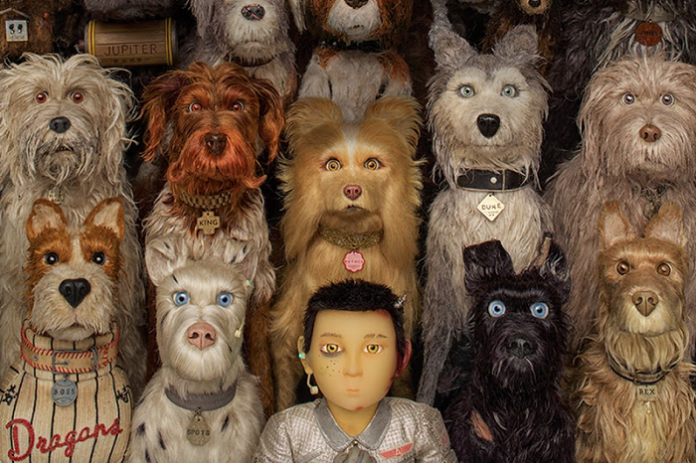Isle of Dogs (2018), is the newest stop-motion animation film from famed director Wes Anderson, known for such works as The Grand Budapest Hotel (2014), Moonrise Kingdom (2012), and Rushmore (1998).
 Isle of Dogs is Wes Anderson’s second stop-motion animation film. His first, Fantastic Mr. Fox (2009), is an adaptation of the famous children’s book written by Roal Dahl. Fantastic Mr. Fox was praised by many for its beautiful cinematography, story-line, and overall incredible use of stop-motion animation.
Isle of Dogs is Wes Anderson’s second stop-motion animation film. His first, Fantastic Mr. Fox (2009), is an adaptation of the famous children’s book written by Roal Dahl. Fantastic Mr. Fox was praised by many for its beautiful cinematography, story-line, and overall incredible use of stop-motion animation.
But, what is stop-motion animation, and how does it work? Also known as stop frame animation, it is an animation that is captured one frame at a time. Physical objects, in this case, animal figurines, are moved slightly after one frame is captured. The slightest movement created by the object is captured. This process requires diligent work and time to get it perfect. The end result is playing back the sequence of images rapidly, creating the illusion of movement.
Storyline:
IMDB stated the overview of the movie:
 “When, by executive decree, all the canine pets of Megasaki City are exiled to a vast garbage-dump called Trash Island, 12-year-old Atari sets off alone in a miniature Junior-Turbo Prop and flies across the river in search of his bodyguard-dog, Spots. There, with the assistance of a pack of newly-found mongrel friends, he begins an epic journey that will decide the fate and future of the entire Prefecture.”
“When, by executive decree, all the canine pets of Megasaki City are exiled to a vast garbage-dump called Trash Island, 12-year-old Atari sets off alone in a miniature Junior-Turbo Prop and flies across the river in search of his bodyguard-dog, Spots. There, with the assistance of a pack of newly-found mongrel friends, he begins an epic journey that will decide the fate and future of the entire Prefecture.”
Isle of Dogs was a project that took four years to make. Mr. Anderson wanted to put on screen dogs that looked somewhat similar to most audiences but that had qualities that go beyond what one could imagine. Mr. Anderson took great strides to make the dogs have untraditional characteristics such as not having traditional hind legs and instead, having the dogs with two sets of front legs.
Making the Puppets:
Wes Anderson worked with the best professional animators for his film to look perfect. He worked with Andy Gent, the head of the puppets department, also known for his work for in the Grand Budapest Hotel(2014).
 Mr. Gent who, instead of sketching ideas, used clay instead to sculpt the sample dogs. Then, those would be analyzed and refined into what became the final characters. More than 70 artists worked on his puppet team. Building the set and the models took great diligence and practice and some 500(Wow!) dog puppets were made for the movie. For the main characters, the filmmakers used real dogs for reference to observe their movements and mannerism. This helped the designers of the puppets animate the characters on film.
Mr. Gent who, instead of sketching ideas, used clay instead to sculpt the sample dogs. Then, those would be analyzed and refined into what became the final characters. More than 70 artists worked on his puppet team. Building the set and the models took great diligence and practice and some 500(Wow!) dog puppets were made for the movie. For the main characters, the filmmakers used real dogs for reference to observe their movements and mannerism. This helped the designers of the puppets animate the characters on film.
The puppeteers start to sculpt in plasticine. After it had been approved, they made a mold of the character. The following process was then to build the armatures, being the metal inside the puppet that is able to control the character’s every movement. The artists then paint ed the mold and placed silicon on top of the armatures which gave the skin of the human or dog. Further, they painted the necessary details of the human puppets. For the dogs, all fur seen on the dogs was real fiber from sheered animals.
ed the mold and placed silicon on top of the armatures which gave the skin of the human or dog. Further, they painted the necessary details of the human puppets. For the dogs, all fur seen on the dogs was real fiber from sheered animals.
Movie Critics:
With an IMDB score of 8.2, a Metascore of 81, and Rotten Tomatoes of 92%, Isle of Dogs was loved by the audiences and film critics alike.
“A winningly dippy hodgepooch of lo-fi sci-fi, band-of-outsiders adventure and the most meme-ready canine antics you’ll find outside of YouTube.” – Guy Lodge, Variety
” Isle of Dogs, the director’s ninth feature and second foray into stop-motion animation, is as precious, minutely detailed, and magnificently deadpan in its humor as any of his previous work.” – Christopher Orr, The Atlantic
“Wes Anderson’s ninth feature film (his second in stop-motion animation) is his wildest and waggiest yet, expanding his wondrous, inventive vision while retaining his meticulous compositions. ” – Jeffrey M. Anderson, Common Sense Media
 Although praised by many, Wes Anderson’s movie sparked controversy over the depiction of Japan. Many commentators have accused it of racism and “cultural appropriations.” The film’s dystopian world is seen as “ugly in ways beyond what even its maker could have intended.”(The Telegraph) The voice cast is not East Asian and the fact that the dogs speak English while the residents of Megasaki spoke Japanese angered many.
Although praised by many, Wes Anderson’s movie sparked controversy over the depiction of Japan. Many commentators have accused it of racism and “cultural appropriations.” The film’s dystopian world is seen as “ugly in ways beyond what even its maker could have intended.”(The Telegraph) The voice cast is not East Asian and the fact that the dogs speak English while the residents of Megasaki spoke Japanese angered many.
Nevertheless, the movie is a story that is one of a kind. The policing of cultural sensitivity stifles the possibility of the imagination, fertilization, and invention of the world of Wes Anderson. Mr. Anderson said,“The movie is a fantasy, and I would never suggest that this is an accurate depiction of any particular Japan. This is definitely a reimagining of Japan through my experience of Japanese cinema.”
Isle of Dogs came out on March 30.

Sources:
https://www.nytimes.com/2018/03/21/movies/isle-of-dogs-behind-the-scenes-wes-anderson
https://www.telegraph.co.uk/films/2018/03/22/wes-andersons-isle-dogs-sparks-controversy-depiction-japan/
http://ew.com/movies/2018/03/22/isle-of-dogs-controversy-roundup/
http://www.imdb.com/title/tt5104604/






